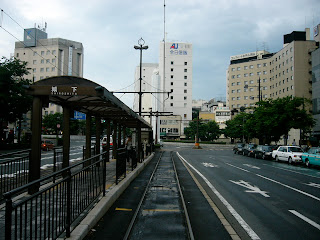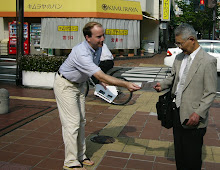
SUMMARY
There are many things we can do to attract more tourists to Okayama and keep them here longer. Most importantly, we need to give them more distinctive sights to visit, as suggested in the other sections of this blog. Our goal, as we saw in the sections on Tsukimi-bashi, the Asahigawa Lantern Walk, and the Marunouchi Historical Park, should be to fill out a “circuit” of must-see sights that will be substantial enough to keep tourists here in Okayama for at least one night. We can also reach out to independent travelers from other countries by inviting a successful hostel chain to open a private hostel in central Okayama.
DESCRIPTION
Okayama Tourist Circuit
With the enhancements suggested in the other sections of this blog, it is possible to complete an impressive circuit of tourist sights in our city. Some of the lesser-known attractions that already exist along this incipient "tourist circuit" include the Orient Museum, the Prefectural Art Museum, and the Hayashihara Art Museum.
For travelers using public transportation, we can say that this "circuit" begins and ends with the experience of riding on the Momotaro-dori streetcar:


Unless travelers are very lucky, they won't ride on the old fashioned "Kuro" trolley car shown above, but rather on a more modern version.

Certainly it would be a good idea for Okayama to purchase more old-fashioned cars like "Kuro" if these are available. But all of the streetcars offer tourists a convenient and pleasant ride from Okayama Station to the Okayama Culture Zone.
The first stop on the circuit is at the Shiroshita-eki streetcar stop:


This streetcar stop is very close to the river and castle grounds, but the view of the Nishimaru defensive earthworks is blocked by the wall of buildings in the background (center and right).
Directly facing Shiroshita streetcar stop is the Hare no Kuni Okayama Kan, part of the Okayama Symphony Hall complex:

The Hare no Kuni Okayama Kan offers an excellent selection of distinctive local products for visitors to choose from:



It also provides a wealth of free travel information for locations around the prefecture:

The Hare no Kuni Okayama Kan is an excellent place for visitors to start or finish their visit to the Okayama Culture Zone.
To continue our circuit, let's get our bearings with an aerial photograph:

The yellow push-pin marks the Shiro-shita streetcar stop and the Okayama Symphony Hall complex. From there, we can follow the orange line either to the Orient Museum (blue push-pin) and/or the Prefectural Museum of Art (green push-pin), or straight to the river. We proceed next across Tsurumi-bashi at the top of the picture, to Korakuen. Exiting Korakuen to the south, we cross Tsukimi-bashi (green eyedropper). The yellow line shows a path around the Castle (along the suggested route of the Asahigawa Lantern Walk), back to Tsukimi-bashi, and then west towards Shiroshita streetcar stop. Alternatively, the blue line moves through the Castle, crosses the Inner Moat, and takes in the Hayashihara Art Museum (red push-pin), before making its way back to Shiro-shita.
The red line at the lower-left of the picture indicates an ideal location for a youth hostel (along Oranda-higashi-dori). The other eyedroppers in the photo are:
Pink: Uchisange Kindergarten (ideal location for a teahouse or cafe)
Blue: Sakakibara Hospital (ideal location for park facilities like a bandstand, open-air pavilion, or amphitheater)
Purple: Former Uchisange Elementary School (ideal location for an upscale ryokan).
As the above photograph shows, adding a few new sights and facilities will help link together the wonderful sights we already have, and make the most of them. Let's add these new elements so that Okayama will mean more to travelers than just Korakuen and a bus ride.
Future addition to the public transportation links in the Okayama Culture Zone ("Won't you ride with me along the Okayama Grand Tour?"):

Drawing independent travelers
Just like Japanese tourists, foreign tourists seek special places where they can transcend their everyday experience. But they have some special needs that Okayama can serve, such as the need for convenient public transportation links, evening entertainment options, and inexpensive hostel-style lodging. Okayama would be in excellent position to fulfill both needs if it could attract a quality hostel chain to open up a branch in central Okayama, near public transportation links, entertainment, and the city’s major tourist sites.
Hostels attract independent foreign travelers not only because they are inexpensive, but also because they provide (a) free services like laundry, left luggage, and internet access, (b) free information on local travel opportunities, (c) a kitchen for self-catering, and (d) a place to meet other independent travelers and have fun. A popular Tokyo hostel is the Sakura Hostel in Asakusa:


A private hostel like this one would be a valuable addition to Okayama’s tourist infrastructure. An ideal location would be along Oranda-higashi-dori (marked by the red line below):

Here’s a picture of this street, looking towards Okayama Symphony Hall:

This site is convenient to public transportation (such as the Kencho-dori trolley stop and the Tenmaya bus stop), shopping (Tenmaya, Lotz, Maruzen, Omote-cho, lots of traditional family shops), information (Okayama Tourist Information center, Megalo Internet Café, Okayama Prefectural Library), dining and entertainment (restaurants and bars of Omote-cho and Nakasange-cho), and tourist sites (Okayama castle, Korakuen, Asahi River). This location is also ideal because it is a business district with almost no private family homes.
By attracting a top-quality hostel chain to open a branch in Central Okayama, Okayama can aim to become a regional “base” for independent travelers. Toward this end, Okayama can leverage its convenient transport links and its splendid International Villas, located in picturesque towns around the prefecture.
As a regional travel “base,” many travelers would stay in Okayama not just for one night but for one or two weeks. Organizing group trips with fellow travelers to the International Villas or using Okayama’s public transportation links to places like Himeji, Kurashiki/Washuzan, Naoshima, and the Kibi Road, hostellers would be able to explore an extensive range of sites from a convenient and inexpensive base. This is Okayama’s best opportunity to distinguish itself as a destination for foreign travelers.

No comments:
Post a Comment